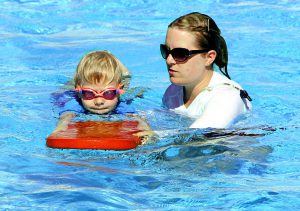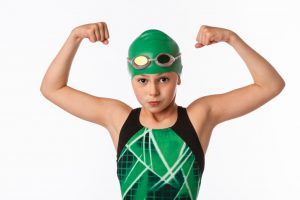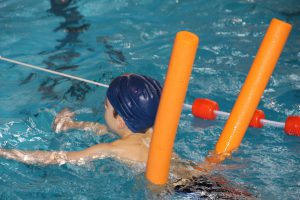Swim Lessons. This might seem like a common sense solution but you would be surprised how many parents wait too long to get their child comfortable in the water. If you own a pool or are frequently around bodies of water it is important to get your child acclimated with the water as soon as possible to prevent drowning. Parents picture worst-case scenarios everywhere, when it comes to bodies of water, their fears are valid. For children ages 1-4, drowning is the most common cause of death, and second most common for ages 5-14. But there is a simple step you can take to calm your fears, keep your kiddos safe, and get their little bodies moving. Swim lessons not only reduce drowning risk by an amazing 88%, but they also have many other benefits for children of all ages!
For All Ages
Even infants are able to learn life-saving water skills. The American Academy of Pediatrics (AAP) suggests starting official swim lessons with babies as young as one year old. By gradually introducing your kiddo to water, it becomes an enjoyable experience, which can combat the aversiveness many toddlers feel when taking swim lessons for the first time.
What To Look For
It’s important to ensure that your children are safe with qualified, responsible adults when they’re first learning to swim. Especially for younger children, a swim lesson with a high schooler in a backyard pool is not adequate without adult supervision. Without proper training a child’s swim lesson could turn dangerous very quickly. Experts recommend looking a swim instructor who:

- Has current CPR and First Aid certifications and has received training through a nationally recognized learn-to-swim curriculum.
- Teaches safety habits around water, not just in it. A good instructor will spend time ensuring that your kiddos know to never go in water without an adult, not to run around pools, and to check for a lifeguard before swimming in the ocean.
- Teaches self-rescue, even from a young age. Things like flipping onto your back, treading water, and keeping your head out of waves are critical skills if your child ends up in water unexpectedly at any age.
- Offers one-on-one attention, lessons in and out of water, and an accessible, patient method for introducing swimming to kids who might be nervous.
While the AAP has not formally recommended infants younger than one year for swim lessons, there is new research on the bradycardic response, or “diving reflex” in infants, where babies who are less than six months old instinctively know to hold their breath and open their eyes under water, and even move their arms and legs like they’re swimming. These reflexes alone are not enough for an infant to swim, but support the idea that babies and young children are born with a primitive understanding of aquatic survival, and with proper supervision and training can quickly learn to master and enjoy swimming.
Many swim schools now offer ‘Infant Self-Rescue lessons for children 6-12 months old.. Babies are, with professional supervision, placed or even thrown into a warm pool and taught to flip onto their back, float, rest, and breathe until someone comes to rescue them. The lessons gradually increases the amount of clothing the child is wearing when put in the pool, to better support the understanding that if they accidentally fall into the water they should turn onto their back to be able to breathe. These lessons might look alarming, but this life-saving skill is invaluable.These classes should only be taught by a certified professional.

For Developing Bodies
On top of being life saving for children, being in the water can be a fun, exciting way to exercise the whole body. Studies show that children who enjoy a physical activity, like swimming, are more likely to have a healthy, positive relationship with exercise in adolescence. In the short term, swimming has many health benefits for little ones, as well:
- Strong muscles, which in turn support proper bone growth
- Cardiovascular exercise that supports young lungs
- Better balance, flexibility, and grasping techniques.
- Better sleep habits (which is a win for everyone!)
For Developing Brains
Swimming is a unique form of exercise in that it requires you to use all of your extremities in different ways simultaneously, while you are also trying to regulate your breathing and stay balanced in the water. All of this hard work does wonders for developing brains. In fact, multiple studies show that children who swim regularly score higher on problem solving and intelligence testing and have an increase in overall efficiency in brain processes.

For children with special needs, swim lessons can be a fun, low-stress lesson in developing fine and gross motor skills, increasing attention span, and regulating the sensory system. If you think your child might benefit from these experiences, ask your Occupational Therapist or primary care physicians if swim lessons are right for your child.
Swim lessons are important for keeping your children safe, but are also a great way to exercise their growing brains and bodies. Swimming can be fun for the whole family, so get in there and start splashing!

